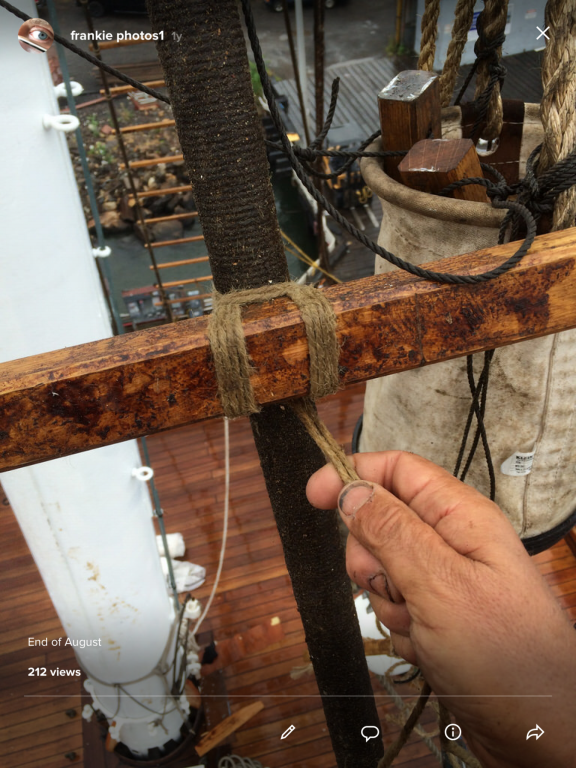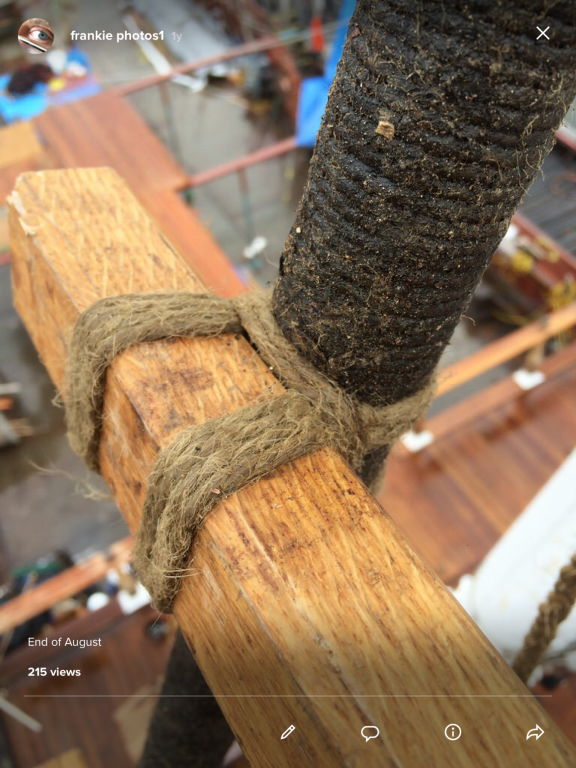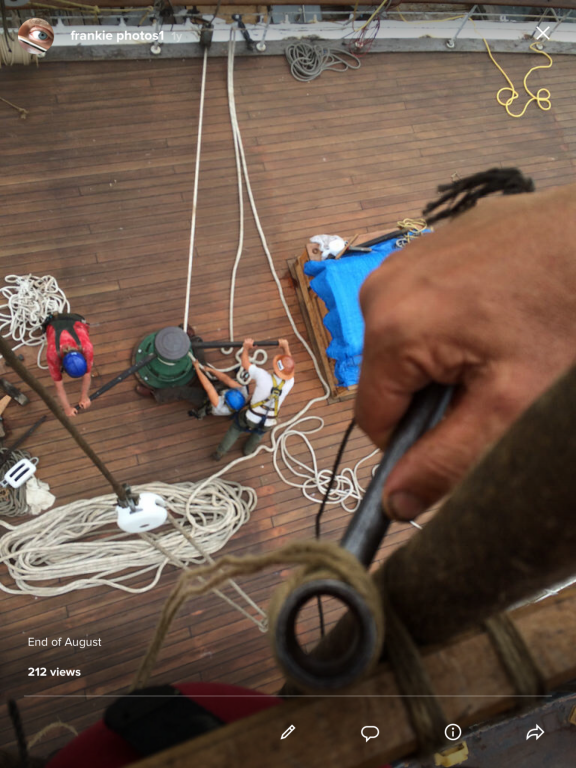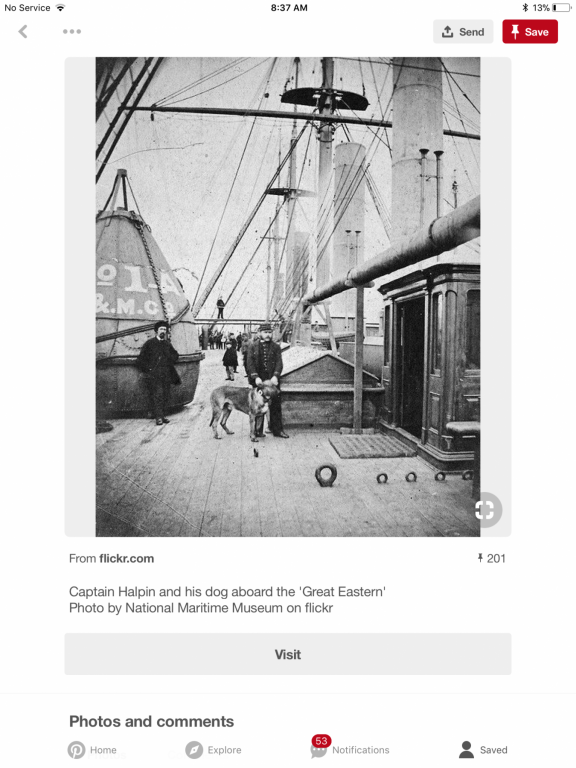
JerseyCity Frankie
Members-
Posts
1,338 -
Joined
-
Last visited
Content Type
Profiles
Forums
Gallery
Events
Everything posted by JerseyCity Frankie
-
Funnel walkways?! Ugh, I don’t want whatever job those walkways entail. I have to imagine it was solidly coated in inches of black soot. The interiors or upper surfaces of the funnels of large ships are not well documented and I would like to know more about them. I know that with steam powered ships their height is a factor of the physics of the rising column of hot air and steam and that forced draft funnels add complexity and machinery to the interior of the funnel. I would love to hear a lecture on the inner life of big ship funnels. Anyone know of any source material on the subject?
-
Can I get some knot advise?
JerseyCity Frankie replied to Antonio Vasquez's topic in Masting, rigging and sails
My advice is just use glue, no knot at all. Knots add bulk and stick out too far in many instances. Don’t get me wrong, I’m a certified knot nerd! I love knots. But sometimes they are too thick when tied on a model. -
Gives you an idea of the true size of flag halyard material. Very thin stuff considering it runs farther than any other line on the ship. About as thick as clothesline or sashcord.
-
Scientific Kit of USS Constituion No. 170
JerseyCity Frankie replied to Nat Fay's topic in Wood ship model kits
Thanks Roger! I did not gain access to any plans from scientific. However, complete Scientific Constitution kits can be found on eBay without difficulty and not too expensive. -
raising and lowering an anchor on a sloop
JerseyCity Frankie replied to timboat's topic in Nautical/Naval History
Why, I wonder, do you feel there isn’t anchor handling gear aboard? Are you looking at a particular vessel? I’m certain there will be a windlass at the very least on any vessel over forty of fifty feet in length, simply because you CANT handle the anchor and cable without one. a very good book that covers many deck evolutions and practices at sea in the age of sailing ships is Seamanship in the Age of Sail by John Harland. Kinda expensive but certainly worth every penny since you won’t find better coverage of the subject anywhere else between two covers. -
Congratulations! Every ship model builder should give Restoration a try. It saves a broken model from continued ignonimity AND it exposes the person doing the restoration to a different perspective since you’ve got to crawl inside the head of the original builder. also, I’d like to believe that long after I’m gone my models could still be viable somewhere in the far future. This is only possible if people like you continue to pour out some love and time on an old broken model.
-
Another thought: grind down the bulkheads on their outboard ends. Or shave them down with a sharp chisel/Sanding blocks. Leave the crown of the deck where it is at the keel. Now your deck has curve to it that I believe the kit ommits. Im building Niagara too and I’m laying the deck on the bulkheads and I note the deck looks completely flat. TEAM NIAGARA!!
-
If it was me? I would go for a scribed deck. Using a pencil to draw the seams works but I find pencil lines look like pencil, the dull lead color. Colored pencil is better. But scribing the seams is worth investigating too especially if you’re going to use paint or stain, the liquid color goes down into the scribed lines, highlighting them nicely.
-
I too vote for a non-plank solution. As mentioned above, scale becomes an issue. Actual planks do look good, nothing looks more planked than actual planks! But if you can’t get lumber of the proper tiny size you will throw off the scale. But on the other hand, how bad is that? Many decisions in model building revolve around Literal duplication or Artificial representation. The Litteral duplication has its own inherent satisfaction, a thing IS what it IS. but with this come scale issues. You see this sometimes when actual brass is used to make metal objects for the ship, it’s too shiny and often too thick and bulky but it IS actual metal. Likewise when actual cloth fabric is used for sails and actual sewn stitches are used, made with needle and thread. The texture and rows of stitches on such sails are out of scale, but they are “real” and they have their own inherant satisfaction and don’t necessarily offend the eye since they bring something else to the table. Same with a planked deck that is out of scale. in every aspect of model building, there is always some material or technique that can be used to fool the eye and stay in scale by substituting something that IS NOT the actual material used on a real ship. Like paper for sails or plastic for metal. Decisions about materials and scale come down to the intent of the builder, what is the overall Tone of the model? What type of “realism” are you aiming for.
-
I think a good rule of thumb is: if you have the slightest beginnings of glimmers of doubt concerning SCALE on a ship model kt supplied components?You are likely well justified in your skepticism. The challenges faced by manufacturers of supplying grating material for every scale represented by their range of products is going to make it more likely the material they provide you with was chosen for its price and availability rather than its actual scale. The One Size Fits All mentality will win out. But I’ve found gratings on actual ships to vary in hole-size anywhere from about 6” down to 1”. Sometimes perfectly joined and other times very crudely cobbled together.
- 8 replies
-
- measurement
- scale
-
(and 1 more)
Tagged with:
-
What we realy need is for someone to set up and fire a real world 32lb long gun on an actual ship. With a powder charge calculated for maximum range. I’m not sure anyone he’s done this with a full size gun firing a real solid shot in a hundred years. I know the Erie Maritime Museum has done this on land with smaller guns, there is video of this on YouTube. But I’m curious to see something realy big and powerful under at-sea conditions. Exactly how powerful is the recoil? How fast is the recoil of a gun of that weight, rolling on iron-shod wooden trucks on a wet slopping deck on a rolling sea? Maybe it wouldnt recoil very fast or very far, due to the weight of the gun? Or is it more likely it’s going to jerk back with astonishing speed and violence?
-
In my view there is a very common problem in many reference materials concerning the fall of tackles. (The Falls are those parts of the line between the blocks, neither the hauling end or the standing end but the “middle” that goes back and forth over the sheaves of the blocks. The person reaving the line through the blocks has choices to make that will effect the legitimacy of the tackle. For instance where the hauling part of the line emerges from the final swallow on the last block will greatly effect its usefulness to the sailor. It will have no effect on a model with tackle that is never run, but there is usually only one “right way” to reave the line and many “wrong” ways, made more complex with addition of more sheaves and more falls. those doing the illustrations of rigging details very often fail to be specific about the exact sequence of how line is rove through tackle. An example we’ve all likely dealt with are the multi-part purchases on spanker sheets. this reaving confusion manifests very often in cannon tackle illustrations. The relation of the falls of the training tackle to the run of the breaching rope is depicted many different ways. I tend to believe that the breaching rope should be run entirely outboard and/or above the training tackle, not between the training tackle and the carriage. But when there is a ring through which the breaching rope passes on the side of the carriage you need to look at how the recoiling gun can foul the training tackle. If it’s run inside of the training tackle it could conceivably tear out the ring bolts securing the training tackle blocks to the carriage.much of this issue will turn on the exact location of the ringbolts on the bullwarks: how high they are mounted on the bullwarks in relation to the heights of the cascabel on the gun and the imaginary line representing the lead of the falls of the training tackle.
-
I’m inclined to reject any rigging related uses for these odd objects. my view, just a guess, is that 2 and 3 from the first photo are brackets for holding something used on deck and my further speculation is the object could be an iron crank handle to be fitted to the adjacent winch. The semicircular object may at a stretch be viewed as a fairlead for a line, but this is not what fairleads for lines look like. As to the second photo, it’s more puzzling. But I’m very dissenclined to view the odd rectangular shapes as Jam Cleats. Jam cleats are used on small modern sailboats but using them on a large vesel would lead only to the lines jammed in them being forever stuck- the line is too big and the forces involved are too great. My vague theory is that they are merely fenders to prevent a heavy object from damaging the bullwarks from the inboard side. Maybe a boat is stowed in that location?
-
Here’s some photos of me bending on some rat boards on Wavertree two years ago. Note I’m using a Heaver to put each turn on bar tight. This lashing is called a Square Lashing. The wood was, I think, white oak. The lashing material is tarred Marline and as the heaver is applied it’s easy to break the marlin, but if you put it on Just Right the tar will start to squeez out of the fibers. That’s when the turn is on tight enough. When the seizing is complete, that ratboard isn’t going ANYWHERE.
-
Basically any line you see on the diagram that is across the face of any sail when the sail is set would be retracted all the way back to the yard when the sail is furled and would be hard up against whatever lead block it was rove through last. From the point on the yard back, the line would exist and be visible all the way back to its pin on the deck. Many people connect the Clew and Sheet and have them hanging in space to represent the position they would be hovering in if there was an invisible still set sail but in my opinion this is an illogical contrivance. On actual ships, when they downrig all the sails for whatever reason, they also remove all the associated running rigging as there is no reason to leave it up if it’s doing nothing. Hailyards braces and lifts on yards remain though. Note also that the hauling yards- the topsail yard and every yard above it- will be in the lowered position if the sails are furled, or off. Again, some people build bare-polled models with the yards all hoisted into position as if they had sails set on them. But again, in my opinion, this is silly.
-
Black wire for eye bolts/rings
JerseyCity Frankie replied to Johnnyreg's topic in Metal Work, Soldering and Metal Fittings
Bead stringing suppliers and jewelry making suppliers have lots of wire styles and sizes and options. -
It raises interesting questions about ship size and Ground Tackle. And when exactly did sailors switch over to chain for the entire Rode? A rule of thumb kicking around these days is that the anchor rode needs to be eight times as long as the maximum depth in the waters you imagine you will be navigating. Nobody anchors offshore, so the amount needed is certainly finite. But what was considered a comfortable margin for error? then there is ship size. I know large ships had a dedicated Cable Tier within the hull just for cable stowage. But as hull size diminishes,at a certain point the idea of a dedicated interior storage space becomes extravagant since interior space is scarce and the crew traditionally bunk in the Focastle’. They are NOT going to bunk with the wet muddy cable. in my view, a schooner wouldn’t need the cable below decks if it’s a smaller vessel. But this is a guess and I wonder if anyone has a decent drawing of a schooner with a chain locker, or cable tier, forward, below decks?
-
Great Eastern Rigging
JerseyCity Frankie replied to brunelrussell's topic in Masting, rigging and sails
As regards sheets on Fore-and-Aft sails on Great Eastern here are my thoughts. She’s BIGLY HUGE. So the sails are enormous and powerful. Like all sailing vessels you would need to be able to tack her, go about through the wind and get on the other tack. So every Fore-and-Aft sail will need two sheets. Very large robust sheets with enormous tackle on them, to handle the forces involved. I’m picturing blocks as large as watermelons on sheets as thick as your wrist, at a minimum. If you look at Pride of Baltimore II, she’s got a loose footed Fore. When she goes about the crew has to attach a safety line to the Clew just to control the flopping sail during the short period she’s in the eye of the wind and the sail is flapping. The Leeward sheet is taken up on, the sail draws on the other tack, and then this safety line is taken off, it’s job done. Im certain Great Eastern would need this safety line too. Sails as large as hers, as she goes about, would be dangerous deadly thrashing monsters, those sheet blocks would be exactly like wrecking balls destroying everything as they whipped around. Even with the safety lines in place I’m certain that no member of the crew looked forward to tacking. So many masts! So many sails to tack! I’m certain they would go to great navigational lengths to assure tacking happened as infrequently as possible. certainlty the gear on deck to handle the sheets would be correspondingly enormous. I doubt there was ever a pin made that could handle those sheets, I’m betting they had large bits on deck for those. sheeting tight would be impossible in high wind and it seams likely they would have a steam powered capstan just for the sheets? That’s a lot of gear on deck though. -
Great Eastern Rigging
JerseyCity Frankie replied to brunelrussell's topic in Masting, rigging and sails
The website/app Pinterest is a very useful research tool. You can create folders and store any number of photos and keep them organized and freely a ailable. Or you can use it to look at the photo collections of others, AND there is a LOT of historic ship material on Pinterest. And more appearing every day. Here is a pretty good Great Eastern board someone is maintaining, it’s got a LOT of photos : https://pin.it/g36atwlxjvovsv It’s free to use Pinterest. I can’t remember if you can view people’s boards without registering? But it’s a simple and free process to register. I never get spam from them. Here’s an example of a Great Eastern deck photo, showing eyebolts, from the link above: -
makeing sense of rigging plan abbreviations ?
JerseyCity Frankie replied to spongbob's topic in Masting, rigging and sails
The key to the spar identity codes is provided for you in the lower left corner of this plan, where there is a simplified diagram of all the spars and their locations in relationship to each other. -
Congratulations on the color and texture of this model. It’s hitting all the right notes and tones, in my opinion, many builders get the color and texture issue wrong.
- 1,306 replies
-
- syren
- model shipways
-
(and 1 more)
Tagged with:
-
Mast Location on AL Bluenose II
JerseyCity Frankie replied to Osmosis's topic in Masting, rigging and sails
My advice is ignore all landmarks below decks and focus instead on the sail plan. Hopefully the kit came with a full scale one? This will give you the location of The Partners, where the mast pierces the deck, and the Rake of the masts, which will show you the line on which the mast intersects the keel. These two landmarks will unfailably give you what you want. Wearas if you use frame or bulkhead landmarks below decks, the results will be entirely dependant on those elements having been located properly. And if they are off in the slightest your mast will be wrong.
About us
Modelshipworld - Advancing Ship Modeling through Research
SSL Secured
Your security is important for us so this Website is SSL-Secured
NRG Mailing Address
Nautical Research Guild
237 South Lincoln Street
Westmont IL, 60559-1917
Model Ship World ® and the MSW logo are Registered Trademarks, and belong to the Nautical Research Guild (United States Patent and Trademark Office: No. 6,929,264 & No. 6,929,274, registered Dec. 20, 2022)
Helpful Links
About the NRG
If you enjoy building ship models that are historically accurate as well as beautiful, then The Nautical Research Guild (NRG) is just right for you.
The Guild is a non-profit educational organization whose mission is to “Advance Ship Modeling Through Research”. We provide support to our members in their efforts to raise the quality of their model ships.
The Nautical Research Guild has published our world-renowned quarterly magazine, The Nautical Research Journal, since 1955. The pages of the Journal are full of articles by accomplished ship modelers who show you how they create those exquisite details on their models, and by maritime historians who show you the correct details to build. The Journal is available in both print and digital editions. Go to the NRG web site (www.thenrg.org) to download a complimentary digital copy of the Journal. The NRG also publishes plan sets, books and compilations of back issues of the Journal and the former Ships in Scale and Model Ship Builder magazines.





